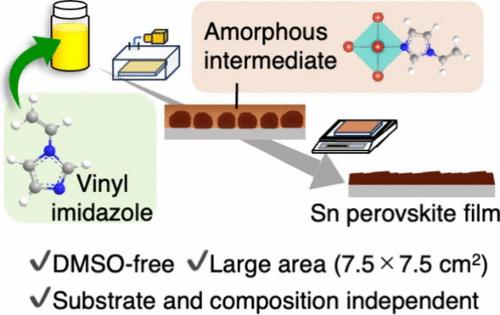Substrate-Independent and Antisolvent-Free Fabrication Method for Tin Perovskite Films via Imidazole-Complexed Intermediates
IF 18.2
1区 材料科学
Q1 CHEMISTRY, PHYSICAL
引用次数: 0
Abstract
The fabrication of metal halide perovskite thin films, particularly those containing Sn, relies heavily on the use of antisolvents. Film quality is strongly influenced by factors such as the choice of antisolvent, the primary precursor solvent, perovskite composition, and the size and wettability of the substrates. This complexity makes process optimization challenging and impedes the development of efficient tin perovskite solar cells (PSCs). In this work, we present a vacuum-quenching with crystal growth regulator (V-CGR) method, an antisolvent- and dimethyl sulfoxide (DMSO)-free, vacuum-assisted fabrication process for tin perovskite films whereby crystal growth could be regulated through the formation of intermediate films containing an amorphous [SnI2–(1-vinylimidazole)] complex. The V-CGR method is compatible with diverse perovskite compositions and substrates, enabling the formation of uniform tin perovskite films up to 7.5 × 7.5 cm2 and allowing device fabrication on hydrophobic hole-transporting monolayers such as MeO-2PACz and 2PACz.

咪唑络合中间体制备钙钛矿锡薄膜的无底物和无抗溶剂方法
金属卤化物钙钛矿薄膜的制备,特别是含锡的金属卤化物钙钛矿薄膜,在很大程度上依赖于反溶剂的使用。薄膜质量受抗溶剂的选择、初级前驱体溶剂、钙钛矿组成、衬底的尺寸和润湿性等因素的强烈影响。这种复杂性使得工艺优化具有挑战性,并阻碍了高效锡钙钛矿太阳能电池(PSCs)的发展。在这项工作中,我们提出了一种用晶体生长调节剂(V-CGR)真空淬火的方法,一种不含抗溶剂和二甲基亚砜(DMSO)的真空辅助制备锡钙钛矿薄膜的方法,通过形成含有无定形[SnI2 -(1-乙烯基咪唑)]配合物的中间膜来调节晶体生长。V-CGR方法与各种钙钛矿成分和衬底兼容,能够形成均匀的锡钙钛矿膜,最大可达7.5 × 7.5 cm2,并允许在疏水空穴传输单层(如MeO-2PACz和2PACz)上制造器件。
本文章由计算机程序翻译,如有差异,请以英文原文为准。
求助全文
约1分钟内获得全文
求助全文
来源期刊

ACS Energy Letters
Energy-Renewable Energy, Sustainability and the Environment
CiteScore
31.20
自引率
5.00%
发文量
469
审稿时长
1 months
期刊介绍:
ACS Energy Letters is a monthly journal that publishes papers reporting new scientific advances in energy research. The journal focuses on topics that are of interest to scientists working in the fundamental and applied sciences. Rapid publication is a central criterion for acceptance, and the journal is known for its quick publication times, with an average of 4-6 weeks from submission to web publication in As Soon As Publishable format.
ACS Energy Letters is ranked as the number one journal in the Web of Science Electrochemistry category. It also ranks within the top 10 journals for Physical Chemistry, Energy & Fuels, and Nanoscience & Nanotechnology.
The journal offers several types of articles, including Letters, Energy Express, Perspectives, Reviews, Editorials, Viewpoints and Energy Focus. Additionally, authors have the option to submit videos that summarize or support the information presented in a Perspective or Review article, which can be highlighted on the journal's website. ACS Energy Letters is abstracted and indexed in Chemical Abstracts Service/SciFinder, EBSCO-summon, PubMed, Web of Science, Scopus and Portico.
 求助内容:
求助内容: 应助结果提醒方式:
应助结果提醒方式:


